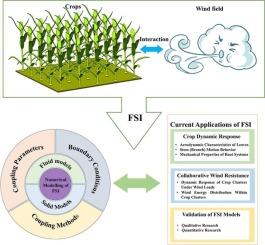流固耦合建模及其在风场与作物耦合研究中的应用综述
IF 8.9
1区 农林科学
Q1 AGRICULTURE, MULTIDISCIPLINARY
引用次数: 0
摘要
风场与作物的相互作用是一个涉及流固力学多尺度耦合效应的复杂动力过程。这种相互作用引起作物的机械反应,如叶片振荡和茎弯曲。它还改变了当地的气流模式和湍流,最终影响了农田的小气候。流固耦合是一个复杂的多物理场、多尺度过程。通过将计算流体力学(CFD)与计算固体力学(CSM)相结合,FSI为模拟这些耦合相互作用提供了强大的理论框架和数值工具。然而,目前还没有系统评价FSI在理解风-作物相互作用中的作用。因此,本文旨在通过综合现有研究成果,评估当前在空间尺度上的应用,并讨论未来的研究方向,系统地评价FSI在风产相互作用研究中的作用。本文首先系统地考察了FSI模型的构建,重点介绍了流体模型选择、实体模型开发、边界条件配置、流固模型参数获取和耦合算法实现等关键方面。随后,对1995年至2025年FSI在风-作物相互作用研究中的应用进行了综述。研究成果从小规模研究(如叶片空气动力学、茎部运动、根系力学)到大规模研究(如冠层风阻、集体空气动力学效应)进行了分类,并总结了相应的验证方法。并指出了目前研究中存在的局限性。最后,本文概述了潜在的优化策略和未来的研究方向,以解决基于fsi的农业管理系统研究中与计算效率、模型准确性和适用性相关的挑战。本文章由计算机程序翻译,如有差异,请以英文原文为准。

Modelling and application of fluid-structure interaction in the study of wind fields and crops interaction: A review
The interaction between wind fields and crops constitutes a complex dynamic process involving the multi-scale coupling effects of fluid-solid mechanics. This interaction causes mechanical responses in crops, such as leaf oscillation and stem bending. It also changes local airflow patterns and turbulence, ultimately affecting the microclimate in agricultural fields. Fluid-structure interaction (FSI) involves complex multi-physics and multi-scale processes. By integrating computational fluid dynamics (CFD) with computational solid mechanics (CSM), FSI offers a strong theoretical framework and numerical tools to model these coupled interactions. However, there has been no systematic review evaluating the role of FSI in understanding wind-crop interactions. Therefore, this review aims to systematically evaluate the role of FSI in wind-crop interaction studies by synthesizing existing research, assessing current applications across spatial scales and discussing future research directions. This review first systematically examines the construction of FSI models, focusing on critical aspects such as fluid model selection, solid model development, boundary condition configuration, fluid–structure model parameter acquisition and coupling algorithm implementation. Subsequently, the paper provides a comprehensive review of FSI applications in wind-crop interaction studies from 1995 to 2025. The research findings are categorised from small-scale studies (e.g., leaf aerodynamics, stem motion, root mechanics) to large-scale investigations (e.g., canopy wind resistance, collective aerodynamic effects), and their corresponding verification methods are also summarised. Moreover, existing limitations in current research are highlighted. Finally, the paper outlines potential optimisation strategies and future research directions to address challenges related to computational efficiency, model accuracy and applicability in FSI-based studies of agricultural management systems.
求助全文
通过发布文献求助,成功后即可免费获取论文全文。
去求助
来源期刊

Computers and Electronics in Agriculture
工程技术-计算机:跨学科应用
CiteScore
15.30
自引率
14.50%
发文量
800
审稿时长
62 days
期刊介绍:
Computers and Electronics in Agriculture provides international coverage of advancements in computer hardware, software, electronic instrumentation, and control systems applied to agricultural challenges. Encompassing agronomy, horticulture, forestry, aquaculture, and animal farming, the journal publishes original papers, reviews, and applications notes. It explores the use of computers and electronics in plant or animal agricultural production, covering topics like agricultural soils, water, pests, controlled environments, and waste. The scope extends to on-farm post-harvest operations and relevant technologies, including artificial intelligence, sensors, machine vision, robotics, networking, and simulation modeling. Its companion journal, Smart Agricultural Technology, continues the focus on smart applications in production agriculture.
 求助内容:
求助内容: 应助结果提醒方式:
应助结果提醒方式:


